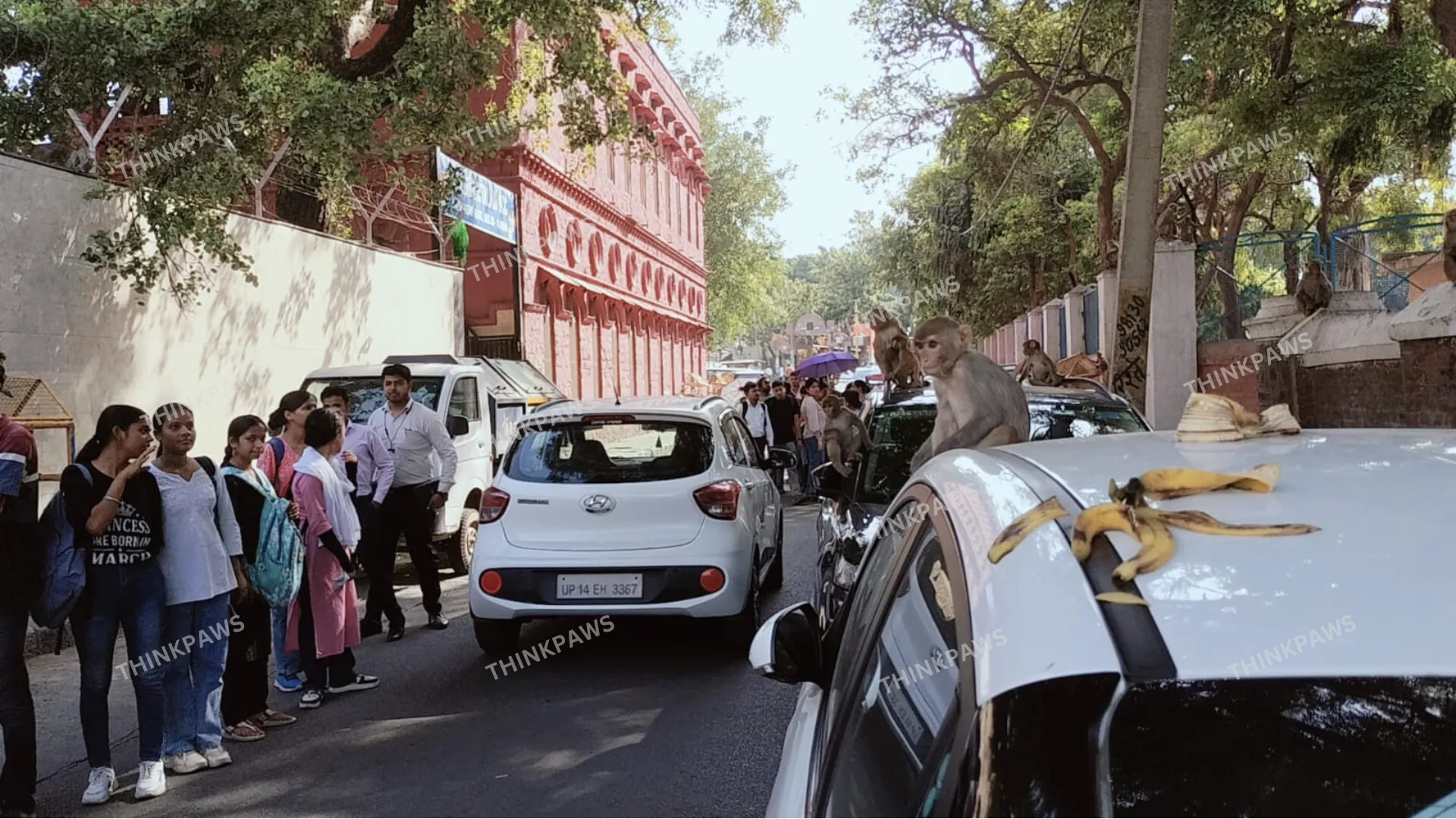Barking dogs that seldom bite: How humans worked with ‘wolves that chose streets’
April 23, 2025
- ID: AR-TSRF-2025-002
- Co-existence, Conflict, Dogs, Ecology, People, Strays, Sustainability, Wolves
Dr. Nishant Kumar
DBT/Wellcome Trust UK India Alliance Fellow (National Centre for Biological Sciences, TIFR & University of Oxford)
Faculty, Dr. B.R. Ambedkar University, New Delhi

‘Old wolf’ on the street side: Unmasking the urban companion’s disguise exhibiting unprecedented cross-species friendship feats
Urbanization, characterized by human-centric design prioritizing structural and colour predictability and aesthetics, inadvertently shapes the ecological landscape for cohabiting species, notably FRDs in streets, monkeys, livestock, crows, kites and pigeons in developing metropolises found in South Asia, Africa and Latin America. Infrastructure elements, from road networks to waste management systems, exert profound influences on their behavioural ecology and survival strategies. The accelerated tempo and spatial constraints of urban development impose novel selection pressures, driving adaptations in these populations of opportunistic feeders. Free ranging dogs (FRDs) are humanity’s oldest companions on the road to civilisation and (urban) development. These adaptations not only reflect the resilience in FRDs but also exemplify the unique cross-species relationships between humans and dogs that flourishes in urban environments. Regrettably, empirical documentation of these adaptive processes remains sparse, impeding our understanding of how urbanization recalibrates interspecies dynamics and resource utilization patterns in shared habitats. These conceptual gaps lead to poor management of urban animals, with interventions like feeding platform creation, translocation, etc., that further exacerbate bite injuries, nuisance and zoonosis.
While discussing how animals variably use sensory systems, let us consider birds; they rely on sharp vision, like avian scavengers that locate carcasses in fields. Many animals sharing urban spaces use varied sensory adaptations. Crepuscular mammalian carnivores, including dog-ancestors, primarily sense(d) through smell and auditory cues, aided by visual sense. Many bats use fine-tuned ultrasonic hearing for navigation. Insects depend on visual or scent cues, or both, based on their ecological roles (called niches) and survival strategies.
Dogs are distinctive for how human-driven artificial selection has reshaped them from their wolf-like ancestors. Before recent artificial selection that gave rise to ~200 modern breeds became the norm for FRDs, this interspecies bond likely arose through a dual process: intraspecific social adjustments among dog ancestors—such as adapting their sociality to thrive in the confined territories alongside (human) hunter-gatherers’ environment—working in tandem with mutual interspecific reciprocity between the two species in these newly human-altered settings. Human and canine ancestors adapted concurrently; a dynamic best explored through the lens of coevolution/co-cultures. Here, changes in one species exert selection pressures on the other, sustaining a reciprocal eco-evolutionary cycle. This would have required canine ancestors to tune their sensory abilities to a human world prioritizing visual traits, while humans increasingly relied on visual (e.g. coat colour; drooped ears and curled tails) and auditory (e.g. barking) cues to select favoured individuals from ancestral populations, deepening this enduring partnership.
This story continues today in cities like Delhi, where conflict and tolerance remain inseparable facets of coexistence. As long as humans refrain from imposing active choices on FRDs’ breeding, the dynamics resemble natural selection, driven by ecological processes that many overlook. People often fail to recognize that behaviour in populations—shaped by the pursuit of resources like food, mates, and habitat—ultimately governs reproductive success. Through vertical transmission of traits and horizontal cultural processes, these interactions give rise to a multiplicity of behavioural strategies, reflecting the variable dispersion of resources across time and space. In their haste to manage FRDs in South Asian streets, residents and city administrators frequently disregard this ecological framework. A thorough understanding of how FRDs adapt within the human niche and urban ecosystems is essential before implementing management, control, or culling measures. Neglecting this context risks unintended consequences, potentially destabilizing the delicate balance that underpins zoonotic disease dynamics in urban environments.
Unlike any other species, FRDs, until 20th century became thoroughly integrated into human societies, serving as sentinels, shepherds, hunting partners, cancer detectors, pets and even “family members”. These intricate relationships between humans and dogs have been the subject of extensive research, with much attention devoted to dog-welfare. Major lack of ecological understanding about FRD behaviours, since most of the literature focuses on captive systems or behavioural patterns, obscures the remarkable story of how humans, guided by visual and auditory cues primed selection benchmarks, transforming wolf-like ancestors (Canis lupus lupus) into a distinct subspecies, the domestic dog (Canis lupus familiaris). Characterized by curved, less furry tails, drooped ears, and juvenile, neotenic features signalling reduced aggression, dogs exemplify this process. Research reveals that their iconic ‘puppy eyes’—evolving over 33,000 years—are no mere coincidence but a slow morphological adaptation tied to domestication. Selective breeding has sculpted expressive, larger-looking eyes and sadder, cuter faces, underpinned by a specialized muscle that lifts the eyebrows. Far from accidental, this ‘puppy dog gaze’ reflects a deep interplay between human preferences and canine evolution. Intriguingly, this trait isn’t unique to domestic dogs; African wild dogs also display it, suggesting that the musculature for such expressions may be widespread within the Canidae family. Such discoveries underscore a period of mutual adaptation between humans and canids—long before modern human-dominated control—where ecological and behavioural dynamics fostered these expressive capabilities, highlighting the profound evolutionary legacy of domestication.
Domestication and Coevolution: The Human-Dog Alliance
The origin of dogs has long been framed as a straightforward tale: early hunter-gatherers adopted less aggressive wolves lingering near human settlements, rearing their pups into the domesticated dogs we know today. Yet this narrative overlooks the sensory and behavioural shifts within dogs that likely underpinned this transition further supplanted by active target breeding as human interventions. How did auditory, olfactory, and visual cues evolve to enable wolf-like ancestors to diverge from their wild kin, giving rise to barking dogs? Recent evidence suggests this was not a simple human-driven process but a gradual coevolution or co-culture, shaped by mutual influences between humans and canids over millennia.
Grey wolves (Canis lupus lupus), the closest relatives of dogs (Canis lupus familiaris), typically roam vast territories, relying on howls and scent marks, before interacting visually to maintain pack cohesion and defend resources with least confrontational costs. In contrast, ancestral dogs faced a starkly different reality: confined to smaller patches near human encampments, they had to adapt to an unprecedented, dense conspecific proximity and a novel ecological niche. This shift demanded adjustments in their sensory toolkit—olfaction for detecting human food subsidies, conspecifics and threats, audition for close-range communication, and vision for navigating human-altered landscapes. Unlike wolves, whose long-distance howls suit expansive territories, early dogs likely recalibrated these signals to thrive amidst humans. Barking, a hallmark of modern dogs, may have emerged as a key adaptation in this context.
The Evolution of Barking: A Human-Influenced Trait
Barking and other vocalization exists across the Canidae family, yet the former plays a minor role in wild species like wolves, where low-frequency howls carry over kilometres. Dogs, however, bark, which is a rapid, repetitive sound distinct from their ancestors’ repertoire; unlike other canids they could also bark for extended periods. Research has shown dogs can distinguish individual barks, suggesting this trait serves a social function beyond mere noise or its hypothetical function in mobbing intruders. Was barking an innovation driven by human proximity? Archaeological and genetic evidence places dog domestication between 20,000 and 40,000 years ago, predating agriculture, when dog-like-wolves likely scavenged human refuse. In this setting, barking could have alerted packs to threats/competition from conspecifics, wolves or other animals or signalled resource availability, benefiting both dogs and humans.
This hypothesis aligns with the idea of barking as an exaptation, a trait that evolved for one purpose but gained new utility in a human niche context. Humans may have favoured barking dogs, intentionally or not, as their vocalizations doubled as warnings against intruders or predators. Over time, selection pressures—natural and human-induced—amplified this behaviour, distinguishing dogs from their wolf kin. Genetic studies reveal that modern dogs carry mutations in stress-response genes (e.g., AMY2B for starch digestion), hinting at broader physiological shifts tied to domestication. Barking, though less studied, likely followed a similar trajectory, evolving as ancestral dogs capitalized on anthropogenic food while maintaining pack dynamics. The resilience of pack dynamics along the urban gradient is not reported from other social carnivores, including canids and other charismatic predators.
However, barking’s full story remains elusive. Its variability—context-specific yelps, growls, or whines—suggests a flexibility tailored to diverse environments. Unlike wolves, whose vocalizations prioritize territory, FRDs additionally bark in response to immediate stimuli: a stranger’s approach, a rival dog, or physiological responses like hunger. This adaptability points to a coevolutionary feedback loop: humans shaped dog behaviour, while dogs influenced human settlement patterns, offering companionship and security. Testing this shall require integrating canine ethology with human archaeology—did barking dogs cluster near denser camps, and did humans adjust their habits accordingly?
Sensory Recalibration in a Human Niche
Ancestral dogs didn’t just vocalize differently; they most likely recalibrated their entire sensory apparatus. Olfaction, their primary sense, honed-in on capitalising over human refuse, a reliable food source unlike the prey-scarce wild. Auditory signals shifted from long-range howls to short bursts suited for interspecific/intraspecific differentiations within relatively cramped spaces. Vision, though secondary in crepuscular wolves, gained prominence as dogs navigated human landscapes—tracking movements of people, livestock, or rivals. This sensory triad, likely prioritized in that order, reflects a trade-off: reduced territorial range for proximity to a stable, novel niche.
Living near humans also meant tolerating conspecifics at closer quarters than wolves could endure. Pack cohesion persisted, but its mechanisms adapted. Where wolves use howls, scent marks to delineate vast boundaries, dogs likely relied on frequent, localized signals—barks, body language, in association with urine marks—to negotiate shared spaces. This adjustment hints at a behavioural plasticity that predated domestication, allowing wolf-like ancestors to exploit human proximity without losing social structure. Over generations, these traits likely solidified corresponding to local ecological factors, variably embedding FRDs within human societies while preserving their canine identity.
Delhi’s Dogs: A Modern Lens
Most likely, barking was an innovation in dogs’ ancestors that were subsisting near humans and gave rise to the most numerous (>1 billion) carnivores in the world, which are distinctive in the visual interaction while operating dog-dog and dog-human socialities. To that end, Delhi’s sprawling urban landscape offers a living laboratory to explore this coevolution/co-cultures. Out there in South Asian cities and similar urban ecosystems, amid landfills and bustling streets, dog families thrive on human refuse as well as ritual feeding. Displaying alloparenting, several males, even older females that rear pups they have not birthed as a unit, echoes ancestral packs. Yet, these shifts in FRDs from traditional aspects of maintaining territories that are relatively a fraction of wolves demands exploration of how dogs reconceptualize space as a proxy for foraging and other resources, while also forming co-cultural ties with people that feed them in same ‘modern FRD territories’. Food abundance might reduce the male’s traditional role as a defender, yet pack bonds endure. How do these dogs perceive threats or decide what to protect when resources are plentiful but unpredictable?
Observing Delhi’s dogs reveals their sensory legacy at work. Barking signals territory disputes or alerts humans to disturbances, while keen olfaction guides them to claim right ad access to scattered waste. Their visual acuity tracks movement—vehicles, people, or rivals—in a chaotic environment. This adaptability mirrors the adjustments of their ancestors, suggesting that domestication’s effects ripple into modern contexts. Studying these populations could clarify how dogs balance dog-dog and dog-human interactions, offering insights into the sensory and social recalibrations that cemented FRDs alliance with us.
In cities, the co-evolution of human and canine societies amidst rapid urbanization and ‘smart city’ ambitions reveals a complex interplay of developmental benchmarks and interspecies tensions. With an estimated 100 million free-ranging dogs across India’s diverse ecological canvas—from Himalayan slopes and peninsula to dense urban sprawls—this relationship is increasingly strained by civilizational shifts. Both species navigate new social-ecological realities, yet their coexistence often falters at the crossroads of intra- and interspecies conflicts. India reports a dog bite every two seconds, contributing to the world’s highest rabies mortality, with over 20,000 annual deaths predominantly linked to canine transmission. In Delhi, where human population density collides with canine adaptability, these incidents underscore a pressing public health crisis. To address this, we must integrate rigorous behavioural ecology into our research framework, examining cognitive mechanisms driving dog-human interactions and population dynamics shaping their ecological footprint. Such an approach—grounded in empirical observation and ecological theory—offers a pathway to mitigate conflict, informing urban planning and zoonotic disease control. As Delhi epitomizes India’s and the larger tropical developmental aspirations, understanding these cross-species sociality tensions becomes not just a scientific imperative but a societal one, demanding multidisciplinary solutions.
An Interspecies Legacy
FRDs with wolves and other cousins have had to adapt to a world that is not truly made for them, a world that continuously challenges their innate senses and habits. The human-dog relationship therefore should defy a linear domestication model. Rather than humans solely ‘taming’ wolves, evidence points to a reciprocal process spanning millennia. Dogs didn’t just adapt to us; they shaped our history, from guarding camps to aiding hunts. Their sensory and behavioural shifts—barking, pack flexibility, niche exploitation—reflect a partnership forged through mutual benefit. Unravelling this alliance demands a dual perspective: canine ethology paired with human ecology. Did barking dogs enable denser settlements? Can human food waste and ritual feeding that has driven canid population booms sustain the welfare of FRDs that face unprecedented challenges in dense, concrete jungles? Delhi’s dogs, thriving amidst modernity, hint at answers, bridging past and present. Their story underscores an extraordinary interspecies bond—one where adaptation, not domination, paved the way for coexistence. As we probe this shared history, we gain not just a window into dogs’ resilience but a mirror reflecting our own evolutionary path.


